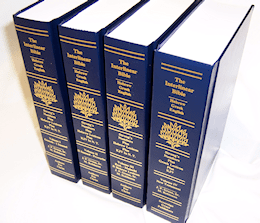Textus Receptus Bibles
Jay P. Green's Literal Translation 1993
| 17:1 | And the lot came for the tribe of Manasseh, for he was the first-born of Joseph, to Machir the first-born of Manasseh, father of Gilead, for he had been a man of battle, and he had Gilead and Bashan. |
| 17:2 | And there was a lot remaining for the sons of Manasseh, for their families, for the sons of Abiezer, and for the sons of Helek, and for the sons of Asriel, and for the sons of Shechem, and for the sons of Hepher, and for the sons of Shemida; these being the sons of Manasseh the son of Joseph by their families. |
| 17:3 | But Zelophehad the son of Hepher, the son of Gilead, the son of Machir, the son of Manasseh, had no sons, but daughters. And these were the names of his daughters: Mahlah, and Noah, Hoglah, Milcah, and Tirzah. |
| 17:4 | And they drew near before Eleazar the priest, and before the son of Nun, and before the rulers, saying, Jehovah commanded Moses to give to us an inheritance among our brothers; and at the mouth of Jehovah he gave to them an inheritance among their father's brothers. |
| 17:5 | And ten portions fell to Manasseh, besides that from the land of Gilead and Bashan beyond the Jordan; |
| 17:6 | because the daughters of Manasseh had inherited an inheritance among his sons; and the land of Gilead belonged to the sons of Manasseh who remained. |
| 17:7 | And the border of Manasseh was from Asher to Michmethah, which fronts on Shechem. And the border went up to the right to the inhabitants of Entappuah. |
| 17:8 | The land of Tappuah belonged to Manasseh, but Tappuah on the border of Manasseh belonged to the sons of Ephraim. |
| 17:9 | And the border went down to the river Kanah, south of the river; these cities of Ephraim were in the midst of the cities of Manasseh, and the border of Manasseh was on the north of the river, and its boundary line was at the sea. |
| 17:10 | Southward, it was Ephraim's. And northward, it was Manasseh's, and the sea was its border. And they met in Asher on the north, and in Issachar on the east. |
| 17:11 | And Manasseh had in Issachar and in Asher, Beth-shean and its daughter-villages, and Ibleam and its daughter-villages, and the inhabitants of Dor and its daughter-villages, and the inhabitants of Endor and its daughter-villages, and the inhabitants of Taanach and its daughter-villages, and the inhabitants of Megiddo and its daughter-villages; three regions. |
| 17:12 | But the sons of Manasseh had not been able to occupy these cities, for the Canaanite determined to live in this land. |
| 17:13 | And it happened, when the sons of Israel became strong, they put the Canaanites to tribute, but did not completely expel them. |
| 17:14 | And the sons of Joseph spoke with Joshua, saying, Why have you given to me one lot and one portion as an inheritance, since I am a numerous people? For Jehovah has blessed me until now. |
| 17:15 | And said to them, If you are a numerous people, go up to the forest for yourself, and you shall cut down for yourself there in the land of the Perizzite, and of the giants, if Mount Ephraim is too narrow for you. |
| 17:16 | And the sons of Joseph said, The hills will not be found for us. And every Canaanite who lives in the land of the valley has a chariot of iron, those that are of Beth-shean and its daughter-villages, and of him who is in the valley of Jezreel. |
| 17:17 | And spoke to the house of Joseph, to Ephraim and to Manasseh, saying, You are a numerous people, and have great power; you shall not have one lot, |
| 17:18 | because the hill is yours; because it is a forest, you shall cut it down, and its outer limits shall be yours; for you shall expel the Canaanite, even though it has chariots of iron; even though it is strong. |

Green's Literal Translation 1993
Green's Literal Translation (Literal Translation of the Holy Bible - LITV), is a translation of the Bible by Jay P. Green, Sr., first published in 1985. The LITV takes a literal, formal equivalence approach to translation. The Masoretic Text is used as the Hebrew basis for the Old Testament, and the Textus Receptus is used as the Greek basis for the New Testament.
Green's Literal Translation (LITV). Copyright 1993
by Jay P. Green Sr.
All rights reserved. Jay P. Green Sr.,
Lafayette, IN. U.S.A. 47903.